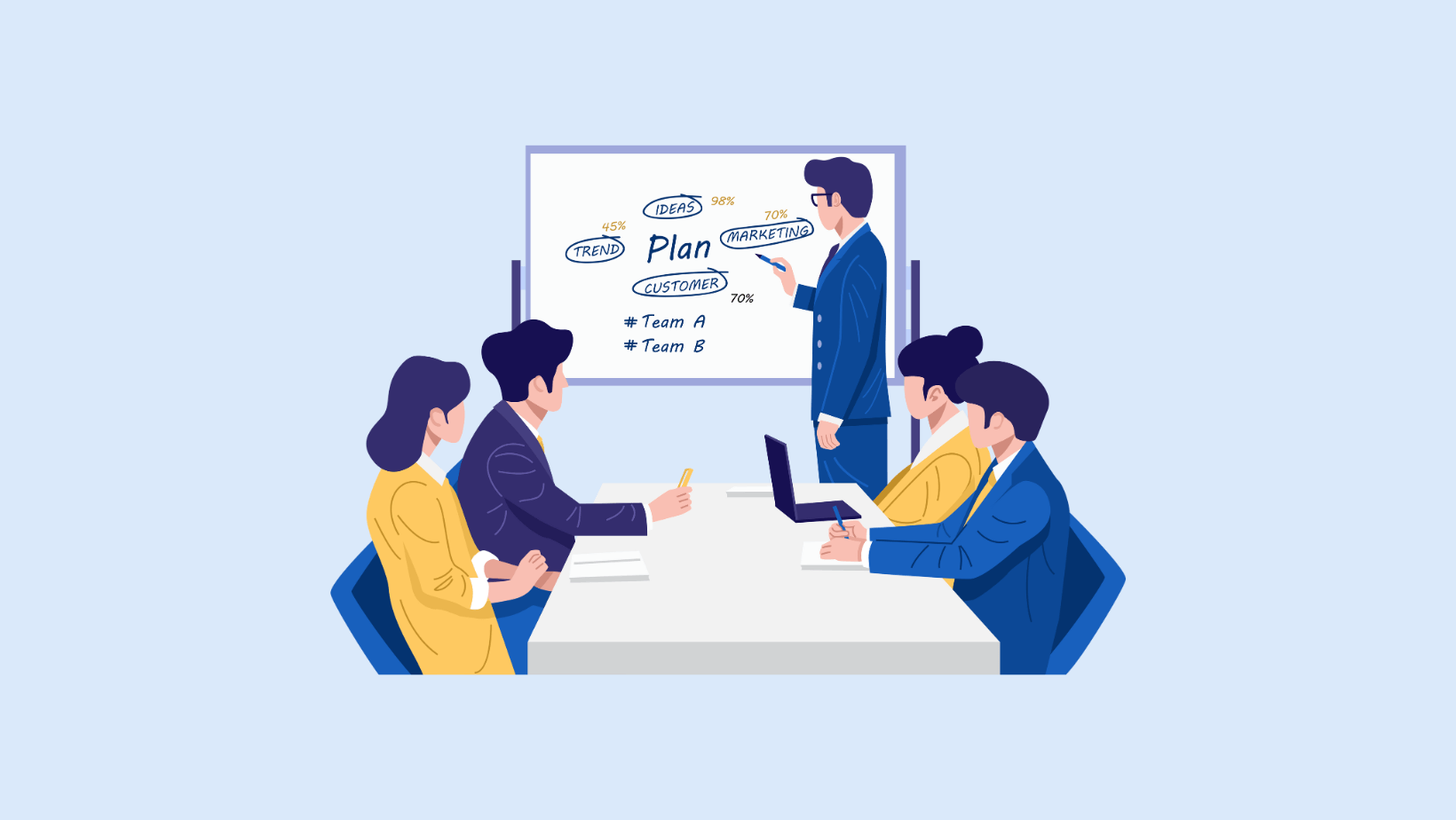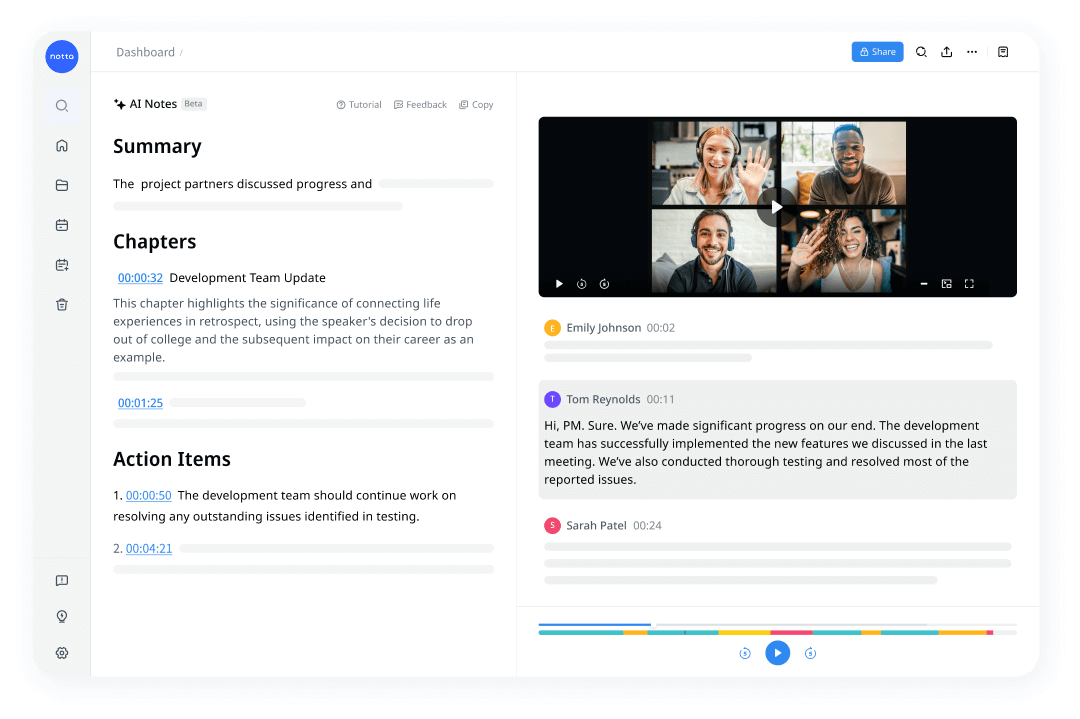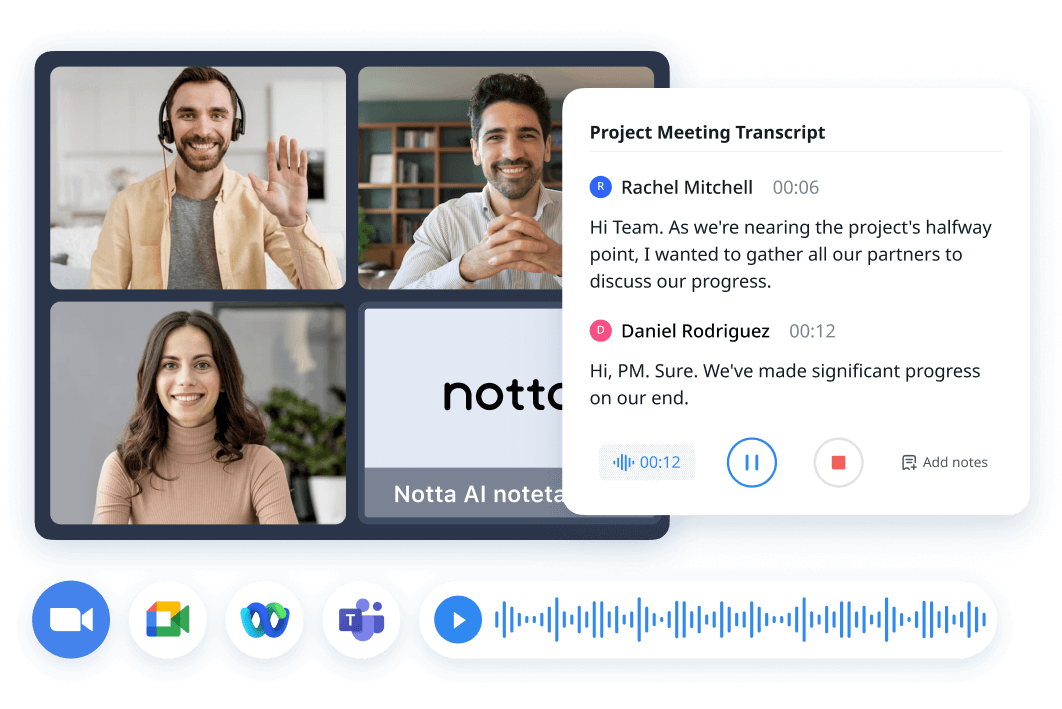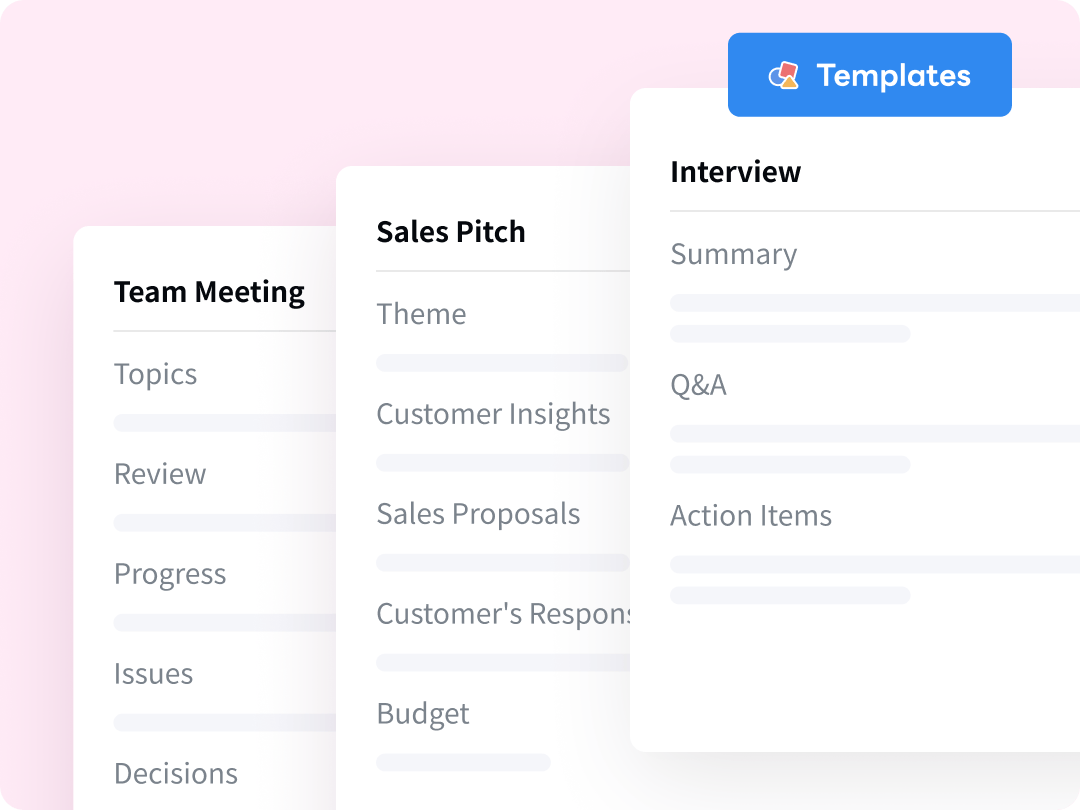Read next: how to hold a stakeholder meeting

How to Run an Effective Leadership Team Meeting [+ Templates]
Unlock the power of AI — Notta's meeting assistant records, transcribes and summarizes meeting minutes with one click.
Stressful leadership meetings feel like a waste of time — I know they have been for me. It often looks like topics are going off the rails, and important things are getting sidetracked. I believe there can be many reasons that can derail your leadership meetings at any point — but the most important is the lack of a meeting agenda.
When you have a leadership team meeting agenda, everyone — including the executive team — understands the purpose of the meeting and how they will reach the goal. I've been attending leadership meetings for a while now, and an agenda helps keep the entire meeting on track. If you're planning to host a leadership team meeting, I'll help with everything you would need to get started.
What is a leadership meeting?
A leadership meeting is a gathering of top-level executives, key stakeholders, and managers within the company. Its purpose is to make important decisions that can benefit the company and help everyone reach their goals and objectives.

It also helps everyone be on the same page — and contribute to the company's growth. But here's an important thing: the meeting structure might vary depending on the purpose and participants. Let's explain the types of leadership meeting briefly:
Executive meeting: It typically involves high-level executives who focus on three main goals: resource allocation, performance review, and overall strategy.
Board meeting: It involves directors who mainly focus on the governance and decision-making process of the company.
Departmental meeting: Sometimes known as a divisional meeting, it is mainly hosted to discuss the goals and challenges of different departments in the company.
What to include in leadership team meetings?
Effective leadership meetings don't just happen. Instead, they need to be planned. The first step is to nail down the purpose of the meeting so the team can avoid focusing on the wrong things and save valuable time. Before you plan anything, ask yourself: What do I want to achieve with this leadership meeting?
Once you've got the answer, the next question is: What should be included in leadership team meetings? Well, the exact answer will depend on the type of meeting and what you're planning to achieve. Here, I'll reveal some key things that must be included in leadership team meetings:
Updates: If you're hosting the meeting, you should start it with some updates about yourself and the company. Remember, you're all busy people and might not always have the opportunity to connect. When you start the meeting in the right way, it will set the tone for the rest of the meeting.
Metrics: The leadership team meetings involve tracking processes on metrics and OKRs. While there are a lot of metrics that you would need to cover, it's important to pick 3 to 5 metrics to focus on week over week.
Wins and insights: Your meeting is incomplete if you don't share wins and insights with the team members. This will help everyone understand what's working and what's not. Appreciation can go a long way. When you appreciate team members, it helps them work hard and achieve goals.
Allocate tasks to different team members: Before you start the meeting, it's a wise idea to allocate tasks to different team members. This helps everyone take a closer look at the progress of their departments.
Address the issues: If you think there are certain issues that were not solved throughout the meeting, it's time to address them. It's best to arrange the issues in such a way that the most important ones are at the top.
Conclude with action items: At the end of the meeting, you'll need to write the individual priorities and overall team objectives. It's important to help the attendees get a clear understanding of what you expect from them in a month or two.

Transcribe meetings, summarize important details and automate scheduling with Notta
Leadership team meeting agenda template
I've put together a leadership meeting agenda template that's customizable so you can make more sense of your meetings. The template is like your team's espresso shot — quick, effective, and energizing. It informs everyone of what's done and what's next.
Updates
You can start the meeting agenda by sharing some updates so all the attendees are on the same page. For example, you can write, ‘The marketing team has successfully launched a campaign.’
Metrics
Next, it's time to include some metrics and OKRs to identify the company-wide goals or initiatives. These metrics should be revisited month to month so you can hit goals on a consistent basis. It could be ‘How many users signed up this month?’
Wins
Here, you can include some points to discuss where the team performed well. You must note why the objectives were met, too! For example, the wins could be ‘We successfully met the new daily user record.’
Roadblocks
The agenda is incomplete without mentioning the specific details about what exactly went wrong or what challenges the team faced while meeting the goals. In challenges, you can talk about budget and resource allocation — if you find them relevant.
Action Items
Lastly, you'll need to include the action items or the next steps for the attendees.
Tips for leading an effective leadership team meeting
Once you have the leadership team meeting in place, it's time to execute it. Here are a few more tips to run an effective leadership team meeting.
1. Prepare high-quality meeting agenda
A proper meeting agenda is one of the best ways to ensure the discussions don't go off-topic. When you have a meeting agenda template, it helps you identify the meeting's goal and make sure everything that needs to be discussed in the meeting is covered. But you need to keep it short and concise — and remove topics that can be addressed via email or text.

2. Send the meeting agenda in advance
There's no use in emailing the meeting agenda to the attendees right after they enter the meeting. The right thing to do is to send the agenda to the attendees at least 48 hours before the meeting. This way, everyone can actively participate in the conversation and keep their questions ready for discussion.
3. Record meeting notes
There are often a lot of things that you'll need to do for a productive and meaningful meeting: take notes, stay on the agenda, and make sure everyone is heard. However, things can go sideways when a lot of people are talking at once. Instead of asking an attendee to take notes, you can choose AI meeting assistants and note-taker apps like Notta. It's an AI tool that records the entire virtual meeting, provides an automatic transcription, and also helps you create an accurate summary of said text.

Transcribe meetings, summarize important details and automate scheduling with Notta
4. Ask your team for input
Whenever I host a meeting, I follow the simple strategy of ‘Discuss, not tell.’ And, in my opinion, this helped me improve the meeting outcomes. If you are planning to host a meaningful leadership meeting, always ask the attendees for their input. Maybe they have some ideas they want to discuss with others to improve the overall collaboration.
5. Send a meeting recap to the attendees
Once the meeting concludes, you should send the recap to attendees. It should typically include important details discussed in the meeting so attendees can refer back to the notes whenever needed.
If you don't want to spend time creating the recap manually, I suggest you check out the Notta AI transcription and meeting note-taker app. It can transcribe recordings accurately and generate a meeting recap for you in seconds.
You can then share the transcripts and summaries with the attendees with just one click! It's essential to improve clarity and help them understand the next steps.
Key takeaways
Effective leadership meetings require a solid agenda, preparation, and a clear purpose. You need to focus on the most important details and ensure everyone in the meeting remains on the same page.
If you want to save some valuable time and complete meeting-related tasks efficiently, the Notta AI meeting assistant is worth trying!
It's an AI tool that can help schedule meetings, record conversations, and transcribe what's said in the meeting. Its AI summary feature can help you summarize lengthy transcripts and create an action item list in minutes!

FAQs
Why are leadership meetings important?
The leadership meetings are great for building trust and a strong connection with team members. They serve as a platform where the team leaders and executives come together to make strategic discussions, collaboration, and problem-solving.
Who should attend leadership meetings?
The leadership team meetings are often a gathering of managers, top-level executives (CEO, COO, CFO, and other relevant executives), and key stakeholders of an organization.
What is the purpose of a leadership conference?
The leadership meetings are the gatherings where problems are solved, and decisions are made. These conferences also help leaders stay up to date on trends and collectively think of ways to help their company grow.